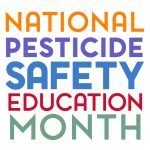February marks the beginning of the seventh annual National Pesticide Safety Education Month. Since 2017, various non-profits and government agencies have participated in this annual awareness campaign. In this article, we’ll highlight the purpose of this campaign and provide you with helpful safety resources.
About the National Pesticide Safety Education Month
The Pesticide Environmental Stewardship organization partnered with NC State University’s Center for Integrated Pest Management to create this safety awareness month. Its purpose is to reinforce principles of safe pesticide use and support land-grant university Pesticide Safety Education Programs (PSEPs).

Any group interested in using pesticides safely can participate. The current list of partners includes the U.S. Environmental Protection Agency (EPA), the Weed Science Society of America (WSSA), the American Phytopathological Society (APS), and the Entomological Society of America (ESA).
Why February? According to Ohio State University PSEP coordinator Mimi Rose, choosing a winter month “reinforces education before many pesticide users are getting ready to apply pesticides in the spring.”
The Need for Pesticide Safety Training
Over 1 million certified pesticide applicators are working in the United States. today. According to a 2017 study, the nation uses 1 billion pounds of pesticides every year. When used properly, pesticides are considered safe by the EPA. They safeguard our homes, prevent disease, and protect our forests.
However, improper application can cause unintended exposure and create negative effects. Overuse, spills, spray drift, and improper disposal are a few ways that pesticides can unintentionally harm people, animals, and the environment.
With such a tremendous amount of annual pesticide use, safety training and education is a vital step to reducing pesticide incidents.
Safety Basics
Proper pesticide use is situational. But here are some steps that apply to most situations.
- The most common pesticide safety tip is to read the label. Our courses often remind students that “The label is the law!” All applicators are legally required to read and follow pesticide labels. For a professional applicator, this step is not optional.
- Follow all applicable laws and regulations concerning the use of pesticides and personal protective equipment. This step can include getting licensed to apply pesticides professionally.
- Measure and mix pesticides in well-ventilated areas away from children, pets, toys, and food.
- Calibrate and maintain application equipment so the amount of pesticide applied will be accurate, uniform, and legal.
- Properly dispose of any excess spray mixture, empty containers, and contaminated cleanup material and clothing.
Advanced Safety Training
The general tips above apply to everyone, from homeowners with an ant problem to large-scale agricultural pest managers. However, professional pesticide applicators usually require more thorough education and training.
One of the purposes of National Pesticide Safety Education Month is to promote PSEPs. These programs teach applicators how to safely use restricted-use pesticides in agricultural, commercial, and residential settings. Most states have at least one PSEP available.
In 2016, we partnered with faculty and graduate students from the Mississippi State University Extension (MSUE) to develop our pesticide education curriculum. Thanks to this partnership, we’ve helped make PSEP material accessible nationwide through online courses.
Our course offerings include state-approved continuing education (CE) for existing applicators. If you’d like to finish your CE online and ditch the classroom, select your state under the Recertification tab at the top of this page to get started.
Interested in getting your pesticide applicator license? Find all our exam prep courses under the Initial Certification tab. We use video lessons to make sure you’re ready to pass your state’s exam and get licensed.
Additional Safety Resources
We believe everyone should learn how to use pesticides safely and responsibly. In addition to the courses we’ve already mentioned, here are a few additional resources to help support that goal.
- Professional pesticide applicators should know about the EPA’s Occupational Pesticide Safety and Health page. It provides industry news updates, shares safety guidelines, and lists the symptoms of pesticide poisoning.
- Farmworkers: Make sure you know about Project LEAF (Limiting Exposures Around Families). Its mission is to increase awareness of take-home exposure risks caused by pesticide residue. Through Project LEAF, the Association of Farmworker Opportunity Programs offers training and other educational materials.
- Professional applicators should use this link to report unintended pesticide exposure and harm. You can also learn more about the recently released Incident Data System here.
- The Pesticide Environmental Stewardship website has lots of resources available for applicators. Find information about reading labels, proper disposal, pesticide storage, and more.
- Our news page has many other articles related to safety, industry news, and application tips.
We hope that during National Pesticide Safety Education Month, you’ll explore new safety training opportunities before the upcoming application season.
Sources
Entomological Society of America. (2021, February 1). February’s National Pesticide Safety Education Month Highlights Nationwide Efforts to Promote Safe Pesticide Use. Retrieved from https://www.entsoc.org/februarys-national-pesticide-safety-education-month-highlights-nationwide-efforts-promote-safe
Ohio-Kentucky-Indiana Water Science Center. (2017, March 23). Pesticides. Retrieved from https://www.usgs.gov/centers/ohio-kentucky-indiana-water-science-center/science/pesticides#overview
Pesticide Environmental Stewardship. (n.d.). February 2024 National Pesticide Safety Education Month. Retrieved from https://pesticidestewardship.org/wp-content/uploads/sites/4/2024/01/2024-Flyer-Print-or-Post-Online.pdf
Pesticide Environmental Stewardship. (n.d.). National Pesticide Safety Education Month. Retrieved from https://pesticidestewardship.org/national-pesticide-safety-education-month/
Pesticide Environmental Stewardship. (n.d.). Some Basic Pesticide Safety Principles. Retrieved from https://pesticidestewardship.org/national-pesticide-safety-education-month/pesticide-safety-principles/
U.S. Environmental Protection Agency. (2021, February 4). EPA Celebrates National Pesticide Safety Education Month. Retrieved from https://www.epa.gov/pesticides/epa-celebrates-national-pesticide-safety-education-month
U.S. Environmental Protection Agency. (2023, December 21). Why We Use Pesticides. Retrieved from https://www.epa.gov/safepestcontrol/why-we-use-pesticides
U.S. Environmental Protection Agency. (2023, July 27). Common Causes of Pesticide Incidents. Retrieved from https://www.epa.gov/pesticide-incidents/common-causes-pesticide-incidents
